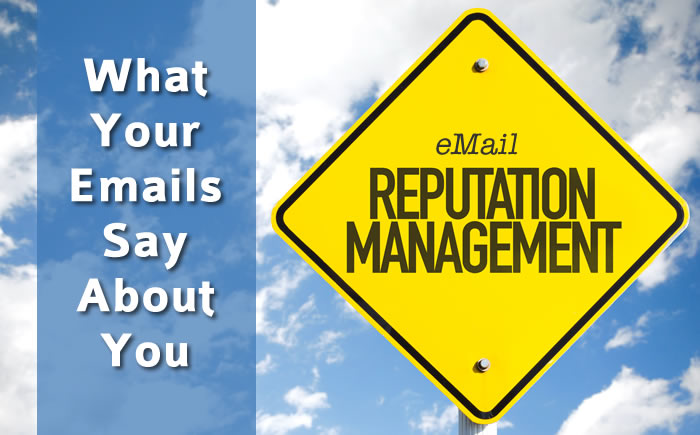15 Crucial Guidelines That Will Prevent You and Your Business From Looking Unprofessional
When embarking into the wonderful world of business, it’s a sad fact that you are instantly set up to be judged.
Prospective clients do it all the time – judge us for our service, the quality of our product, whether our prices are too high or too cheap… there’s a lot of judgement going on that can adversely affect our reputation for sure!
But one of those judgments, whether you realize it or not, is a by-product of our email correspondence.
Business emails can be a brand reputation killer if you're not carefulClick To TweetEvery day, we send emails to business associates, prospective clients, resources and clients. Have you ever taken a moment to really think about what your emails are saying about you?
More specifically, what unintentional impression are you giving the recipient?
Are you giving them ample opportunity to misjudge your intentions and even your personal and professional brand?
With every email you send out, you either make a favourable impression towards your overall business brand, or create a terrible impression towards your professionalism.
Some days I deal with hundreds of emails coming in and being sent out. That’s a lot of correspondence – and a lot of opportunity for judgement.
Sadly, with time being sparse and smart phone auto-correct, too often little details can be left out or inadvertently included that can suggest that you’re lazy, incompetent, inattentive, mistrustful, or unprofessional. Yikes.
Below lists 15 critical guidelines to keep in mind when sending emails to avoid looking unprofessional. Some may seem like a no-brainer, but it doesn’t hurt to have them serve as a reminder when you’re sending out your emails today:
-
Use Your Business Domain Email
Many times I receive an email from a business owner who uses a free email service like Gmail, Hotmail or Yahoo etc. If you’re one of these people, it’s time to change your emails to your business domain.
Free services like these give the impression you are not really a professional. Yes, using Gmail is handy but you can still use it by adding in your POP3 or IMAP email account for your business.
And ‘yourbusinessname@hotmail.com’ doesn’t count. If you want to be taken seriously, then take your business branding seriously too by using an email address such as ‘yourname@yourbusinessname.com’.
-
Check Your Spelling
Always double check your spelling before hitting the send button.
Keep in mind email spell checkers don’t know when you’ve used a correctly spelled, but incorrect word such as “their” instead of “there”. Also be aware of similarly spelled words such as “lose” and “loose”, which I find is commonly done.
-
Avoid Using Slang/Texting Jargon
It may be Ok for personal instant messaging, but not in a professional email. Using shortened text such as “this 1 is 4 u” is a definite no-no. Somehow this style of “English” has permeated from social media and text messaging to regular communications – stop doing that!
Another pet peeve of mine is the salutation – starting your email with “Hey there” is not going to provide a favourable impression on your professionalism.
-
Use Proper Grammar
Grammar is not just for picky English teachers. If your writing is grammatically incorrect, it has a much higher probability of being misinterpreted and misunderstood by the recipient. Often in this instance, mis-communicating is worse than not communicating at all.
-
Use a Signature Block
Do all of your emails contain a short, professional eSignature with your contact information? Don’t make people look in their address book if they want to call you.
Have your information automatically inserted in every message. Add in a brief, catchy sentence and of course, be sure to put your website address there too!
It’s important to note to make sure your eSignature looks professional and reflects your business brand accordingly. Glittery rainbows, funny cartoons and even inspirational quotes do not belong here. Each can send a very strong impression about you that you may not want to have happen.
-
Have a Useful Subject Line
Use the subject line to communicate useful information. Let the recipient know what the email is about so they can decide what to do with it.
Useless subjects, no subjects at all, or misleading ones can be really annoying.
Also avoid putting your entire message into the subject line. Yes, this happens. Please don’t!
-
Format for Ease of Reading
Writing large, impenetrable blocks of text in one long stream of consciousness paragraph is very hard to read in an email. Break up your prose so it’s easier to follow.
Along similar lines – make sure you don’t WRITE ALL IN CAPS or even all in lower case. Both show extreme unprofessionalism so use proper sentence case.
-
Keep Them a Reasonable Length
Emails should generally be short. Many people find it difficult to read long pages of text on their screen.
Often when too many details are shared much of the message is missed, which can lead to big misunderstandings in the long run.
-
Don’t Abuse the Urgent Indicator
Using the urgent indicator for clearly unimportant emails gives the appearance that you have no regard for the time and attention of the reader… or you suffer from a personality disorder that leaves you with delusions of self-importance.
Either way, it’s not a good impression to give so only use the urgent indicated for truly urgent emails.
-
Note the Attachment Size
Be careful of the size of attachments you send – anything over 1 Mb is TOO LARGE for those people who still get emails over the phone line. It also uses up a lot of data on smart phones.
If there’s no need for sending big files, don’t. If there is, find a way to reduce the size first, use a large-file sending service like Hightail or Dropbox, or let the person know in advance that you’re sending the large file so they can be prepared.
-
Lay Off the Read Receipt
Unless you are sending a very important contract or time-sensitive document, avoid using the read receipt feature.
Most people want to read their emails in private and don’t want to be made to feel you don’t trust them to read your emails.
The exception to this rule is if you fear your email is not being delivered to the intended person and you want to be assured they received it.
-
Proof-Read SLOWLY
Studies show that the human brain can easily “fill in the blanks” of a sentence or not register a double word like “the.” However, that doesn’t mean you have licence to take advantage of that!
When you proof-read your email, carefully read E V E R Y W O R D to make sure your sentence makes sense and isn’t missing anything.
-
Understand the difference between TO: CC: and BCC:
I find a lot of people aren’t sure when to use these fields in their emails. Here’s a rule of thumb to follow:
- If you want a response from one or more people, put their email in the TO: field.
- If you are sending an email to more than one person, the people you are including just as an FYI go in the CC: field. This way they know they are not expected to respond.
- If you don’t want anyone to know that you are sending an email to someone else at the same time, that email address goes in the BCC: field.IMPORTANT: If you are sending an email to a bunch of people that don’t know each other – ALWAYS use the BCC field for ALL email addresses. It is a privacy violation and security risk if you share email addresses with other people in your contact list that don’t know each other.
-
Never send an email when you’re angry or upset
9 times out of 10 you’ll regret it the moment you hit the send button.
Someone got you pissed? Go ahead and write your emotionally charged letter but then walk away without sending it. Come back when you’ve cooled down and either send a re-written letter or better yet, pick up the phone and communicate that way.
There are times when email is simply NOT the best form of communication and the phone is always going to be better when a disagreement has formed, misunderstandings are happening, or emotions get charged.
-
Finally,remember that email does not include tone of voice or body language
The person reading your prose has only your words to work with.
It’s amazing how quickly those words can cause people to jump to the wrong conclusion, misinterpret your intentions and even worse, be offended by the attempt at humour that didn’t quite translate properly.
Your business relies a lot on its brand management and email correspondence is a huge part of how you communicate that brand to others.
By following these simple guidelines with every email you send out, you will be presenting yourself in a professional manner that will surely give a favourable impression to the recipient.
Can you think of any other things that annoy you about email? Write a comment below!
To your business success,
Susan Friesen
P.S. If you liked the article, you might want to subscribe to our newsletter. We publish tons of valuable content to help you learn more about marketing, and subscribing is the best way to ensure you don’t miss out. Additionally, if you’d like to learn more about creating a successful and profitable website, while avoiding costly mistakes, click here for our free report on the 6 Critical Steps to Creating a Successful and Profitable Website.







